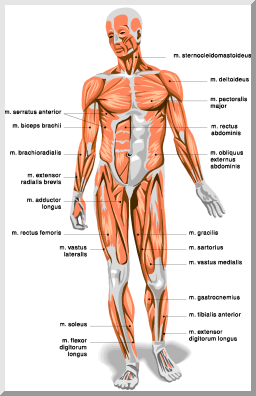
Muscular System
Muscle is attached to bone by tendons and other tissue and exerts force by converting chemical energy into tension and contraction. Muscles move and make us capable of a variety of actions, but muscle only really contracts and becomes shorter: they pull but they cannot push. Muscle is made up of millions of tiny protein filaments which work together to produce motion in the body. Each of more than 600 muscles is served by nerves which link the muscle to the brain and spinal cord. Our bodily needs demand that muscles accomplish different chores, so we are equipped with three types of muscle: cardiac muscles, found only in the heart, which power the pumping action throughout life, and "smooth" muscles, which surround or are part of the internal organs. Both of these muscle types are involuntary and are not under any conscious control. The third type is muscle we use when we will action; they are what aches after a ten-mile hike, and are called "skeletal" muscles. These carry out voluntary movements and make up about 23%% of the woman's body weight and about 40%% of a man's and are the body's most abundant tissue.
The Muscular System

Go back to homepage: Click Here